
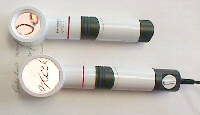
Several years ago I purchased an illuminated magnifier at an auction. It was a useful tool, providing its own light and 4 power magnification. One day, when trying to photograph a document under difficult lighting conditions in a court clerk's office, I put my camera on top of the illuminated magnifier. Wow! I was delighted to learn that by resting the 35mm camera with its smallest extension tube on top of the illuminated magnifier I could capture an excellent image.
Eventually I purchased a digital camera and tried the camera with the magnifier. And again it was a perfect match. This might not work with every digital camera. The one I use has a 10X optical zoom resulting in a lot of flexibility.
With these discoveries, my illuminated magnifier became the most used item in my arsenal of equipment. Document examiner friends asked where to get one like it. I did an Internet search. After a web visit and some in-depth phone conversations, I ordered a range of products which are manufactured in Germany by Eschenbach.
Everything that you see here has been tested in my office and found to be useful for document examination. Of course, if you are a stamp or coin collector, electronic assembler, or just like to examine life closely, you will find these products interesting. Please feel free to call 919-556-7414 or email me with your comments or questions. And remember that if a picture is worth a thousand words, a well-lit, magnified image speaks volumes.
Shedding Some Light on Your Document Problems
The illuminated magnifier I use so much is actually part of a system of illuminated magnification products by Eschenbach. There are several types of magnifiers available. A stand magnifier is excellent for any type of work because the magnifier body is its own stand. Your hands are free for other tasks.
Illuminated stand magnifiers have two parts - the head and the handle. The head is a circular or rectangular unit which consists of a housing and the magnifying lens. I prefer the round head because camera lenses are round. There are heads available at several magnifications (3X, 4X, 4.2X, 5X, 6X, 7.5X, 10X, 12.5X).
According to the laws of optics, as magnification increases, the field of view decreases. Also, as powers of magnification increase, there is some distortion as you look away from the center of the lens. Eschenbach minimizes this distortion by using a lens with aspheric curvature. But the price of using an aspheric lens is that the eye must be at a specific working distance from the lens to avoid the distortion.
After a thorough examination of the various lenses available, the ones I find most useful are 4.2X and 7X. The 4.2X head has a comfortable working distance and a useful field size. With either a 35 mm camera plus extension ring or a digital camera plus zoom, the 4.2X yields good detailed photos. For those situations where a closer image is needed, the 7X head is my choice. The heads are fully interchangeable. No matter what handle you decide on, any head will match. If you have several heads and just one handle, and the net result is that you have several magnifiers.
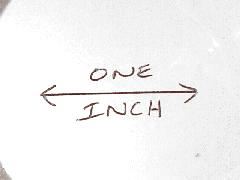
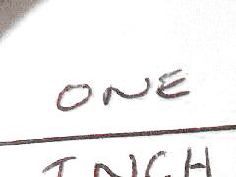
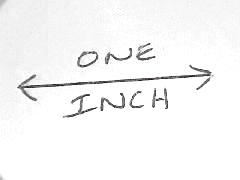
4.2X - A useful range of magnification. These photos show the widest and closest images captured using a Sony digital camera with 10x optical zoom. A useful range of magnification. These photos show the widest and closest images captured using a Sony digital camera with 10X optical zoom.
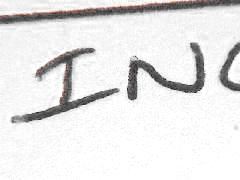
6X - The 6X head also provides a good range of magnification, but the working distance is not as comfortable as with the 4.2X head.
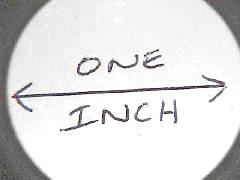
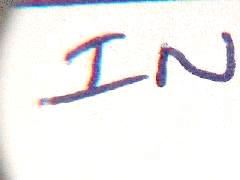
7X - A good close-up and an acceptable wider view, although the magnifier head is now visible in the wider shot.
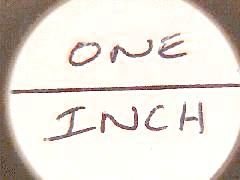
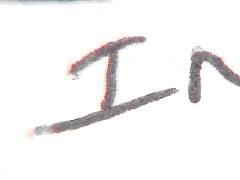
10X - The wide shot is less than one inch across. A good close shot, but some distortion is creeping into the edges.
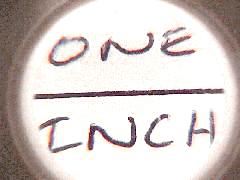
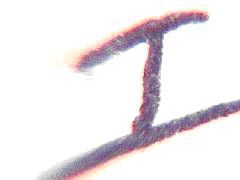
12.5X - To get the really close view with the 12.5X head, you have to accept considerable distortion of the image as you move away from its center.
The second part of the magnifier is the handle. The handle is designed so that when it is connected to the head the entire unit will lie flat on a table to form its own stand. Three types of handle are available: an incandescent battery handle, and a halogen handle, and an LED handle. The bulb types are NOT interchangeable on the handles. The electrical assemblies of the handles are specific to the type of bulb.
A halogen bulb is whiter, brighter, and draws more power than an incandescent bulb. This need for power is the reason that the halogen handle sports a 110-120V power cord. There is actually another option - a halogen battery handle, but it is suggested that it be purchased as a companion to the plug-in handle for use only in special situations. It requires three C size batteries which last approximately three hours.
The incandescent battery handle requires two C batteries which last much longer. Rechargeable batteries can be used in either handle.
The LED handle has the advantage that the LED lamps should not need to be replaced (whereas bulbs burn out and need periodic replacement), and the battery life is extended. However, for document examination, there is no IR content in the illumination, and therefore the LED magnifier is not useful for use with IR filters.
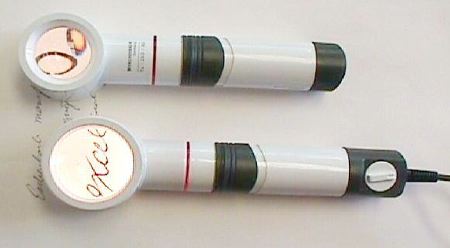
The top unit is an incandescent battery halogen handle with a 7X head. Below that is a halogen pulg-in handle with a 4.2X head. Notice the wider field and less distorted image through the 4.2X head at this working distance (approx. 18 inches). Also note the different colors of light. The rheostat on the halogen handle is set for full power.
To summarize, my personal favorites are the 4.2X and 7X heads. I now own both and select one to use depending on whether fine detail or breadth of field is more important in what I need to see/photograph. If you are purchasing one handle only, consider a plug-in halogen. I find the halogen bulb to be more enlightening - both for the eye and for the camera.
A battery handle is great to have in certain circumstances. You can economize by selecting an incandescent, or you can select a battery halogen if you prefer the brighter light.
Additional Useful Tools
If you need to make careful, distortion-free measurements, Eschenbach offers Precision Scale Magnifiers that accept interchangeable measuring scales. The Precision Scale Magnifiers are available at 7x and 10x. The 7x is most versitile for document examination. Each unit has a clear plastic base which allows light into the field. An option is to combine the unit with an adaptive head that allows the scale magnifier to be used with any of the illuminated handles. Several scales are available. My two favorites are the linear scale and the combination scale.
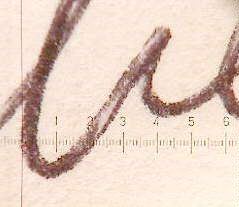
This 7X Precision Scale Magnifier is fitted with a linear scale that is marked in tenths of a millimeter.
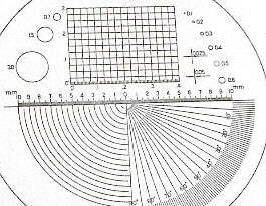
These products are a sampling of the many items offered by Eschenbach. They are featured here because in my opinion they are the tools that would be most useful to a document examiner. If you would like more information or wish to make a purchase, please email me or dial 919-556-7414.
Why ?
Eschenbach is a German company that has been manufacturing precision optics for over 80 years. Eschenbach producst are carefully designed and engineered to be easy and comfortable to use. Each feature has been maximized for its purpose.
Lenses are manufactured from a proprietary compound, PXM®, which has the same optical qualities as glass, but is lighter and more resistant to breaking. Together with the Frauenhofer Institute for Silicate Research, Eschenbach has developed a new coating for the PMX® lenses called cera-tec® which significantly improves scratch resistance. When ANSI (American National Standards Institute) decided to publish standards for Magnification, Eschenbach was on the development team. If you appreciate good tools, you will enjoy working with any Eschenbach product.

Copyright © 2001-2008 Emily J. Will All Rights Reserved.
